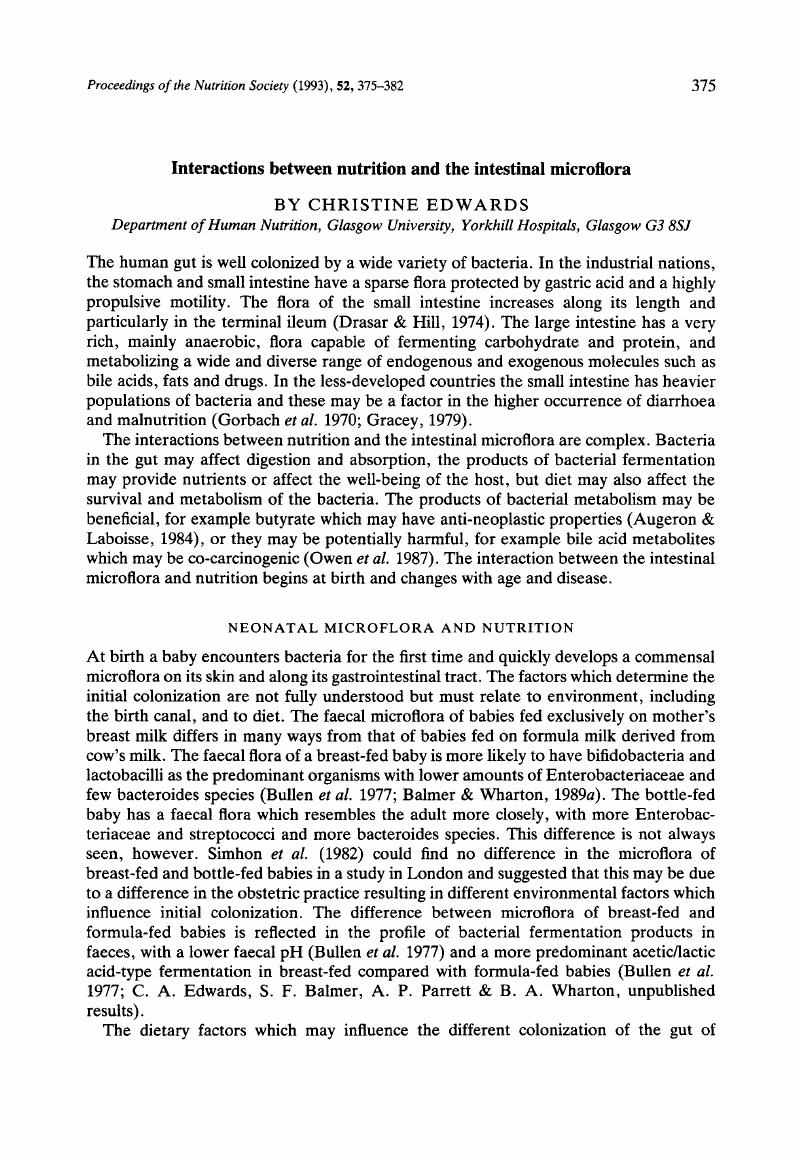Crossref Citations
This article has been cited by the following publications. This list is generated based on data provided by Crossref.
Wolever, T.M.S.
Radmard, R.
Chiasson, J.‐L.
Hunt, J.A.
Josse, R.G.
Palmason, C.
Rodger, N.W.
Ross, S.A.
Ryan, E.A.
and
Tan, M.H.
1995.
One‐year Acarbose Treatment Raises Fasting Serum Acetate in Diabetic Patients.
Diabetic Medicine,
Vol. 12,
Issue. 2,
p.
164.
Bakker, G.C.M.
Dekker, R.A.
Jongbloed, R.
and
Jongbloed, A.W.
1998.
Non‐starch polysaccharides in pig feeding.
Veterinary Quarterly,
Vol. 20,
Issue. sup3,
p.
59.
Hoover, Dallas G.
1999.
Encyclopedia of Food Microbiology.
p.
210.
Mälkki, Y.
and
Virtanen, E.
2001.
Gastrointestinal Effects of Oat Bran and Oat Gum: A Review.
LWT - Food Science and Technology,
Vol. 34,
Issue. 6,
p.
337.
Edwards, C. A.
Zavoshy, R.
Khanna, S.
Slater, C.
Morrison, D. J.
Preston, T.
and
Weaver, L. T.
2002.
Production of13C Labelled Pea Flour for Use in Human Digestion and Fermentation Studies.
Isotopes in Environmental and Health Studies,
Vol. 38,
Issue. 3,
p.
139.
Saarela, M
Lähteenmäki, L
Crittenden, R
Salminen, S
and
Mattila-Sandholm, T
2002.
Gut bacteria and health foods—the European perspective.
International Journal of Food Microbiology,
Vol. 78,
Issue. 1-2,
p.
99.
Christian, M T
Edwards, C A
Preston, T
Johnston, L
Varley, R
and
Weaver, L T
2003.
Starch fermentation by faecal bacteria of infants, toddlers and adults: importance for energy salvage.
European Journal of Clinical Nutrition,
Vol. 57,
Issue. 11,
p.
1486.
2005.
Dictionary of Nutraceuticals and Functional Foods.
Vol. 20051496,
Issue. ,
p.
505.
Lambo-Fodje, Adele M.
öste, Rickard
and
Nyman, Margareta E. G.-L.
2006.
Short-chain fatty acid formation in the hindgut of rats fed native and fermented oat fibre concentrates.
British Journal of Nutrition,
Vol. 96,
Issue. 01,
p.
47.
Lavrenčič, A.
2007.
The effect of rabbit age on in vitro caecal fermentation of starch, pectin, xylan, cellulose, compound feed and its fibre.
Animal,
Vol. 1,
Issue. 2,
p.
241.
Kim, Hyun Jung
and
White, Pamela J.
2009.
In Vitro Fermentation of Oat Flours from Typical and High β-Glucan Oat Lines.
Journal of Agricultural and Food Chemistry,
Vol. 57,
Issue. 16,
p.
7529.
Bautzová, Tereza
Rabišková, Miloslava
and
Lamprecht, Alf
2011.
Multiparticulate systems containing 5-aminosalicylic acid for the treatment of inflammatory bowel disease.
Drug Development and Industrial Pharmacy,
Vol. 37,
Issue. 9,
p.
1100.
Sharma, Monika
and
Devi, Mridula
2014.
Probiotics: A Comprehensive Approach toward Health Foods.
Critical Reviews in Food Science and Nutrition,
Vol. 54,
Issue. 4,
p.
537.
Huang, Q.
Su, Y. B.
Li, D. F.
Liu, L.
Huang, C. F.
Zhu, Z. P.
and
Lai, C. H.
2015.
Effects of Inclusion Levels of Wheat Bran and Body Weight on Ileal and Fecal Digestibility in Growing Pigs.
Asian-Australasian Journal of Animal Sciences,
Vol. 28,
Issue. 6,
p.
847.
Sánchez-Chino, Xariss
Jiménez-Martínez, Cristian
Dávila-Ortiz, Gloria
Álvarez-González, Isela
and
Madrigal-Bujaidar, Eduardo
2015.
Nutrient and Nonnutrient Components of Legumes, and Its Chemopreventive Activity: A Review.
Nutrition and Cancer,
Vol. 67,
Issue. 3,
p.
401.
De Weirdt, Rosemarie
Hernandez‐Sanabria, Emma
Fievez, Veerle
Mees, Eva
Geirnaert, Annelies
Van Herreweghen, Florence
Vilchez‐Vargas, Ramiro
Van den Abbeele, Pieter
Jauregui, Ruy
Pieper, Dietmar H.
Vlaeminck, Bruno
and
Van de Wiele, Tom
2017.
Mucosa‐associated biohydrogenating microbes protect the simulated colon microbiome from stress associated with high concentrations of poly‐unsaturated fat.
Environmental Microbiology,
Vol. 19,
Issue. 2,
p.
722.
Kerr, B. J.
Trabue, S. L.
and
Andersen, D. S.
2017.
Narasin effects on energy, nutrient, and fiber digestibility in corn-soybean meal or corn-soybean meal-dried distillers grains with solubles diets fed to 16-, 92-, and 141-kg pigs1.
Journal of Animal Science,
Vol. 95,
Issue. 9,
p.
4030.
Liu, Shaojuan
He, Liuqin
Jiang, Qian
Duraipandiyan, Veeramuthu
Al‐Dhabi, Naif A
Liu, Gang
Yao, Kang
and
Yin, Yulong
2018.
Effect of dietary α‐ketoglutarate and allicin supplementation on the composition and diversity of the cecal microbial community in growing pigs.
Journal of the Science of Food and Agriculture,
Vol. 98,
Issue. 15,
p.
5816.
Zhao, Yumei
Tian, Gang
Chen, Daiwen
Zheng, Ping
Yu, Jie
He, Jun
Mao, Xiangbing
and
Yu, Bing
2019.
Effects of varying levels of dietary protein and net energy on growth performance, nitrogen balance and faecal characteristics of growing-finishing pigs.
Revista Brasileira de Zootecnia,
Vol. 48,
Issue. ,
Xu, Song
Yu, Zirou
Li, Zongliang
Wang, Zijie
Shi, Chenyu
Li, Jian
Wang, Fenglai
and
Liu, Hu
2023.
Wheat bran inclusion level impacts its net energy by shaping gut microbiota and regulating heat production in gestating sows.
Animal Nutrition,
Vol. 15,
Issue. ,
p.
45.





